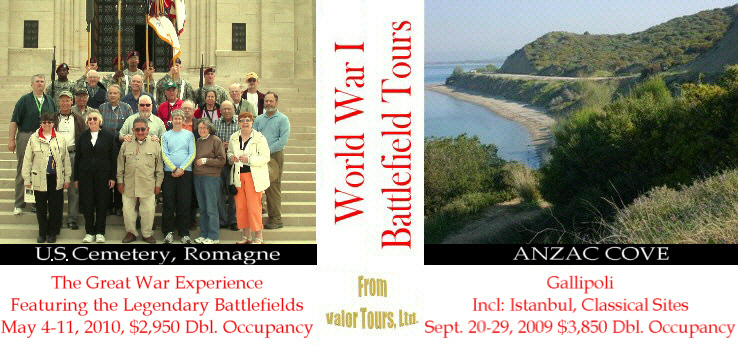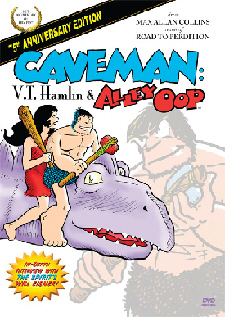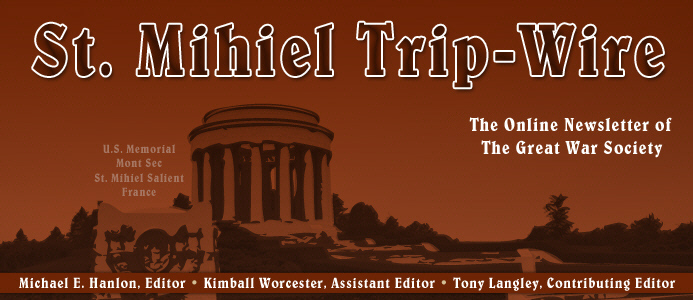

Special Field Report from Normandy:
65th Anniversary of D-Day
TRENCH REPORT: A lot of news from the travel front. I'm still collecting images from our recent WWI battlefield tour, so I'm going to hold off on presenting them. However, I spent early June with another group in Normandy commemorating the 65th Anniversary of D-Day. Below you will find my field report on the goings-on there, including the ceremony attended by four national leaders at the U.S. Omaha Beach cemetery. Finally, my parent travel company, Valor Tours Ltd., has just announced my first 2010 WWI trip for May 4-11. Just click the icon below and we will send you a brochure. After my September 2009 trip to Gallipoli, we will also make an evaluation and decide whether to offer a similar tour next year. MH
This Month's Internet Feature
German Heroes of the Great War Who Later Opposed Hitler
(Inspired by the recent films Valkyrie and Sophie Scholl)
Admiral Wilhelm Canaris
Kapitän Martin Niemöller
General Friedrich Olbricht
The Suicide of Rommel
Michael Cardinal von Faulhaber
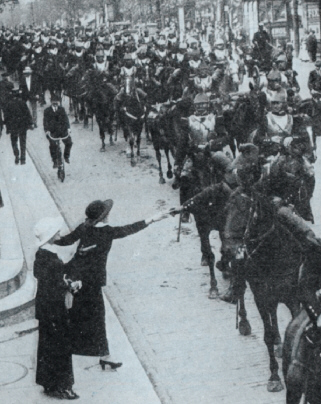
French Cuirassiers on Their Way to the Front
Receiving a Tobacco Gift in Paris
New at Our Own & Our Friends' Great War Websites
Click on Title or Icon to Access
|
Recommended by Our Member Bob Denison
Soldier's Mail
Letters Home from a New England Soldier 1916-1919
At Great War Society Sites
While developing an improved Website, The Great War Society has been careful to hold on to the archival material it has gathered over the last ten years. There are hundreds of articles and thousands of images available at our "Learning and Research Center." Just go to our home page and look for the hyperlink to access it:
At the WFA-USA
|

I can find only one case of science blaming World War I for the extinction of a species. It is the Syrian Wild Ass, whose habitat was so disturbed by the war in Mesopotamia he just couldn't survive.
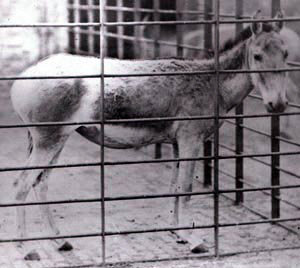
One of the Last at the London Zoo
Please send any other cases of species extinction linked to the war that have been identified.
|
 Recollection of the War, 1922
Recollection of the War, 1922
by Famed American Cartoonist V.T. Hamlin
(See full story in Andy's Nickelodeon below)
|
GREAT WAR 2009 EVENT CALENDAR
|
Western Front U.S.A. &
The Great War Society
Combined 2009 Annual Seminar,
September 11 - 13, 2009
National World War I Museum
Kansas City, Missouri
The and compelling theme for the seminar combines the original seminar ideas for both organizations: "Technology, Treaties and the War: From 'Tin Hats' to Tanks and 'Top Hats' to Territories." Registration forms, fees and further information will be forthcoming. Check back here or at the organizations' Websites for details. (link)
|
Western Front Association
U.S. Branch Chapter Meetings
Check for Your Region
Regularly Updated (details)
|
Great War Society Monthly Chapter Meetings
Berkeley, San Francisco and Palo Alto, CA
Regularly Updated (details)
|
Upcoming Events at the National World War I Museum
Kansas City, Missouri
Regularly Updated (details)
|
Send additions/corrections:
Email Response
|
The Military Vehicle Preservation Association is re-enacting the 1919 transcontinental drive across the U.S. in which Dwight Eisenhower played a major role. Details are on their Website (look for the 2009 Journey Route & Schedule page). (link)
Second Reminder: On Saturday, July 4th, Independence Day, Rin Tin Tin, "the world's most famous German Shepherd," will make a personal appearance at the The National World War One Museum, 100 W. 26th Street, Kansas City, MO 64108-4616. (link)
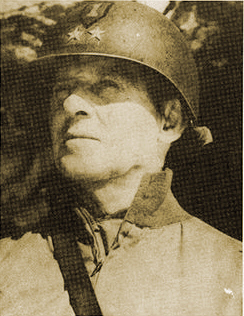
MG Clarence Huebner
General Clarence Huebner (1888-1972) commanded the 1st Division in its assault on Omaha Beach, June 6, 1944 and throughout much of the European Campaign before he was given command of V Corps. During the First World War he had also served with the 1st Division performing brilliantly and marking himself as destined for senior command.

And now I'm drinking wine in France,
The helpless child of circumstance.
Tomorrow will be loud with war,
How will I be accounted for?
From Soliloquy, Lance Cpl. Francis Ledwidge,
Royal Inniskilling Fusiliers (KIA, July 31, 1917)
|
|
|
|
|
Page Two
|
|
|
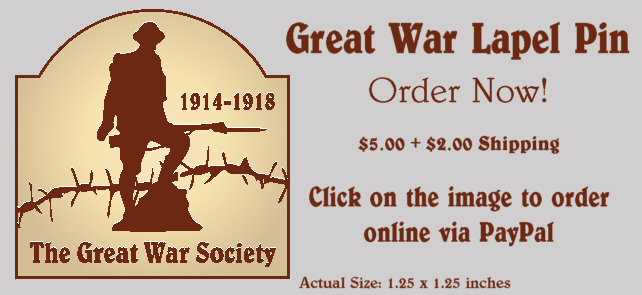 |
Field Report: The 65th Anniversary of D-Day
By Trip-Wire Editor
Mike Hanlon |
In early June I was the leader of group that visited the Normandy invasion sites and got to attend the 65th Anniversary Commemoration at the U.S. Cemetery above Omaha Beach. My regular World War I company, Valor Tours Ltd., had asked me to accompany and lend a hand to their founder, RAF veteran Bob Reynolds on this trip. Bob flew on a mission over the Cotentin Peninsula the night of June 5/6, 1944 dropping chaff to cover the U.S. parachute drops for the invasion making him an authentic D-Day veteran. Since Bob has led this tour for 40 consecutive years my "leadership" of the tour mainly consisted of checking the group into our outstanding hotel, the La Sapiniere, (situated right on Omaha Beach near one of the key breakout points of June 6th) plus saying "good morning" to the group each morning on the bus before handing the microphone over to Bob. This was a blessing for the group because Bob proved to be a great raconteur, knowledgeable historian, and an authentic participant in the actual history being recounted. It was a blessing for me as well because I got to focus more than usual on the sites and events themselves. Here are some of my memories and observations of what was a hectic, but exciting, week in Normandy.
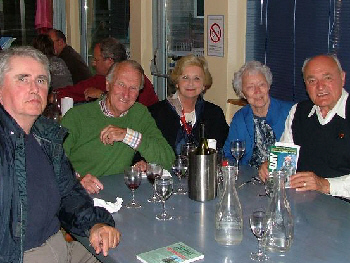
Editor Mike Hanlon, Toni &
Valmai Holt, Betty and Bob Reynolds |
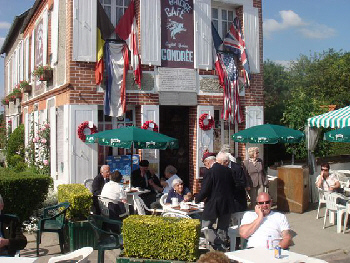
Some of Our Group Among the Visitors at Famed Cafe Gondrée
Adjacent to Pegasus Bridge |
Changes and New Appreciations: It has been 12 years since my previous visit to Normandy and I had lost the feel for just how huge a battlefield it was -- 50 miles from the British sites around Pegasus Bridge on east flank of the beaches to the American drop zone behind Utah Beach in the west. There has been a proliferation of museums, visitors centers, and monuments since my last visit. There is also greater commercialization around the more famous sites, but the only thing that struck our group as unseemly was a nonhistorical festival of some sort featuring loud blaring post-rock music at Utah Beach when we visited there.
The British and Canadian Contributions: I'm afraid my previous visits heavily concentrated on the American sites to the west, but that deficiency was cured this time. (A little detail for the readers: more British and Canadian troops came ashore on D-Day than Americans.) With Bob's RAF flying experience, at Pegasus Bridge he was able to give a very detailed description of the operation that captured the absolutely superb execution of the glider landing and capture of the bridge. Simply an awesome bit of flying and fighting. Besides visiting the British and Canadian beaches, we also made a long stop at Arromanches where remains of the Mulberry artificial harbor can be viewed. There is also an excellent museum dedicated to the harbor right on the beach. In my other lifetime I've been a project manager and planner for new medical centers, large planned communities, and even a nuclear reactor. The Mulberry artificial harbor, however, is simply beyond anything in my experience. Its concept and execution were so grand they can't be appreciated from up-close on the shore, but only from the bluffs high above Arromanches. Imagine the Pharaohs building all the pyramids at Ghiza at the same time--that's the scale of Mulberry.
The Visitors Center at the U.S. Cemetery: We spent an afternoon at the $37 million Visitors Center at the American Cemetery at Omaha Beach. This was the tour's highlight for me. It is simply the finest tribute to America's military heritage I've seen, and I've been to Gettysburg, Arlington, Valley Forge, and almost all of our great memorials and museums. The American Battle Monuments Commission that oversaw its design and construction deserve the highest praise. Considering that it honors one of the greatest victories in our history, it is totally lacking in triumphalism. The center features clever technology and displays, but they are not intrusive and they are beautifully done and give a tremendous amount of information. Visitors learn about the Normandy campaign, its origins and execution, the units that served, and best of all--I can't say this too strongly--leave feeling personally acquainted with a large number of the soldiers who fought for us there. All visitors upon departing are guided blind to a small enclosure where a last statement is made. On a patch of ground is planted an M-1 rifle with the bayonet punching into the ground. Atop is a GI helmet - field grave for an American soldier. Many on our tour reported tears flowing at this point. (Yes, me too.) In the Normandy campaign, as we reported last month, the United States lost more killed in action (29,000) than in any other battle in our history.

Visitors Center - Exterior |
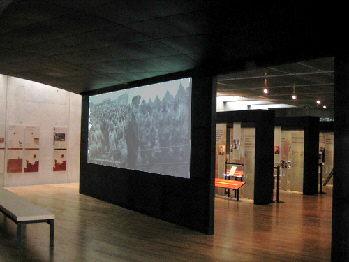
Visitors Center - Interior |
U.S. Military Cult: An amusing discovery was made the day we drove from Paris to the invasion beaches. We started spotting dozens (and later hundreds) of U.S. WWII vehicles on the roads--from jeeps to tank transporters to 6 x 6 trucks--manned by reenactors wearing GI uniforms and gear. It seems that the D-Day anniversary marks an annual meeting and encampment of collectors of U.S. militaria and equipment from all over Europe. It was simply hilarious meeting people from Poland, Greece, and Belgium, who are so "into" things American. A good number of them converged on Sainte-Mere-Eglise the day we visited, but we met with them everywhere we went. My favorites were the "U.S. Navy Shore Patrol," who drove a grey Navy jeep and dressed up like the sailors in South Pacific, wearing white caps, dungarees, "SP" armbands and web belts with billy clubs hanging.
Meeting Readers: I was happy to meet some Trip-Wire readers at Normandy. One evening our hotel manager sent a German gentleman over to my table who was looking for a Mr. Reynolds. It turned out not to be my colleague from Valor Tours he was seeking, but I asked the fellow to join me for a glass of Calvados and he accepted. He said his name was Martin Galle and I responded, "Mike Hanlon," as we shook hands. Martin totally caught me by surprise when he asked, "not the Mike Hanlon?" I was embarrassed as could be, but as it turns out, I am "the Mike Hanlon" Martin had in mind. He has been a longtime reader of this newsletter. But then, more interesting, I got treated to the story why Martin was making his own pilgrimage to Normandy. His grandfather, on his mother's side, commanded the German infantry regiment that was defending Omaha Beach on June 6, 1944. Martin said this was an interesting coincidence because his grandfather was also in the front line of the St. Mihiel Salient when the U.S. Army deployed there in 1918. I have asked Martin to write an article on his grandfather's experiences in both wars and hope to present it in a future issue. Jeffrey Aarnio, Superintendent of the U.S. Oise/Aisne Cemetery and his wife Michelle also said hello at the cemetery ceremony. His own cemetery has been designated in a group of five overseas cemeteries to receive enhanced educational resources for visitors modeled (on a smaller scale) on the Omaha Beach center. His is the only WWI cemetery on the list, so we will be monitoring that project closely. Jeffrey will be attending the Seminar at Kansas City is September, so you will be able to meet him if you are attending. Last, friends Toni and Valmai Holt, founders of Holts Tours and now publishing magnates, dropped by our hotel to visit with Bob Reynolds and myself. This was the second year in a row we were able to visit and we had a pleasant, albeit too brief, time comparing notes. They are redoing their D-Day guidebook and we will post a link to their site when it is ready. I used their current edition to brush up for this trip and it proved invaluable.
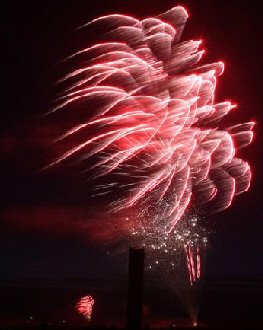
11 p.m., June 5, 2009
From Omaha Beach |
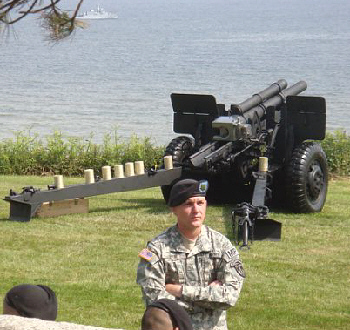
U.S. Soldiers at Cemetery
U.S. Ship Standing Offshore |
Fireworks: The French do fireworks outstandingly well. At 11 p.m. the night before the anniversary there was stupendous display along the 50-mile invasion beach front. From, maybe, six to eight points simultaneous launches were made of spectacular and identical bursts. The effect was stunning and I'll remember it all my days.
D-Day + 65 Years - the Morning: Everyone at our hotel had the same idea -- rise early the morning of D-Day and walk down to Omaha Beach. My room happened to be on the second floor of the hotel and my front door opened to a near-perfect view of the beach. When I opened it that morning, I gasped at the scene I beheld. Overnight a flottila of Allied warships (mostly French apparently) had arrived and were anchored just offshore. I had a bit of the view of a German defender at the same position on that morning 65 years ago. It was another priceless moment for me. Unfortunately, for security reasons, the gendarmes closed off the beach that morning. By the way, they now wear baseball caps instead of kepis. (I wonder when that happened?)
D-Day + 65 Years - the Big Event: The rest of June 6th, of course, was fully focused at the commemorative event featuring the world leaders at the Omaha Beach cemetery, which had a limited, by invitation only, audience of 7,000. For me personally, this was the first time I felt I was at "The Most Happening Place" in the whole world. I won't bore the readers with details about security. It was all understandably necessary, but that doesn't necessarily mean it was fun to experience it firsthand. The U.S. military was an important yet unobtrusive presence. Besides helping with the security, they served a number of other functions like escorting veterans and firing the artillery pieces in the 21-gun salute. The young troops who came by to chat inspired a lot of pride amongst our group. Bob Reynolds became a hero to the group as he somehow wangled a seat on the main stage just four rows behind the first lady. (He seems to know everyone at Normandy.) President Obama hit the right tone in his speech as did President Sarkozy. (Of course, I didn't confirm this until I read a translation a few days later, but the large French-speaking contingent responded pretty positively during the talk.) The British and Canadian Prime Ministers, however, didn't do as well. Mr. Brown sounded a bit strident and seemed to be far more political (commenting more on a laundry list of current issues rather than remembering D-Day) than his colleagues, and Mr. Harper spoke alternately in English and French, making it difficult to follow the logic of his talk. Taken a whole, the ceremony was inspiring, though, and at times thrilling, like when the four national anthems were sung with gusto by the chorus.

Main Stage at Ceremony
65th Anniversary, June 6, 2009 |

European Reenactors at
Sainte-Mere-Eglise |
Corridor of Death Museum: There was a final surprise for me on our return drive to Paris. At Montormel, near Falaise where the famous gap didn't quite get closed, there is a great museum that shows what happened in those critical hours of the Normandy campaign when escaping German units were almost annihilated. The museum designers cleverly set you up. You are first treated to an excellent but conventional audiovisual presentation of the fight in an enclosed, standup theatre. But then doors open, and you instantaneously step on to a platform where you view, several hundred feet below you in a valley, the "Corridor of Death" itself. A+ for its dramatic presentation of military history.
|
|

Spoils of War
|
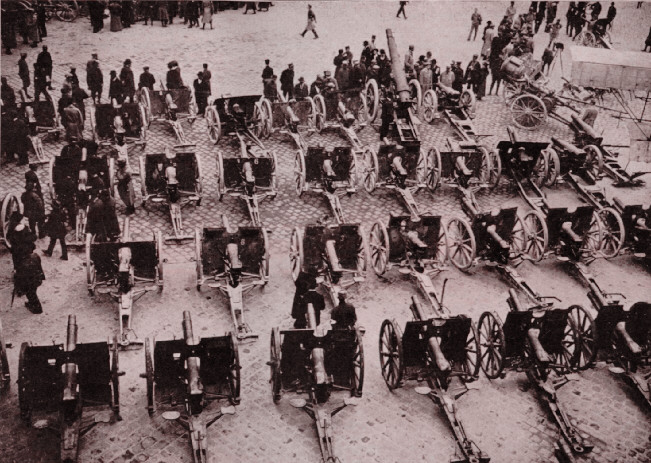
Captured German Artillery on Display in Paris During the War
|
Click Here to Visit the Website of Our Contributing Editor Tony Langley
War in a Different Light
|
|
Subscribe to Our Online Magazine
|
|

|
|
|
Page Three
|
|
|
2009 & 2010 World War I Tours Led by
Trip-Wire Editor Mike Hanlon
Click on image to request a brochure from greatwar@earthlink.net
|
|
John "Jack" Ross, 110, last Australian soldier of World War I died in his sleep on June 3, 2009.(link)
|
|
 |
The White War
by Mark Thompson
Reviewed by Len Shurtleff of Len's Bookshelf
|
The White War: Life and Death on the Italian Front, 1915-1919 is a well crafted and thoroughly researched overview of Italian participation in The Great War, a subject too often ignored by English-speaking historians. The author details the military events on the Italian Front from the opening of the war there in May 1915 through the armistice of November 4, 1918. He also traces the main outlines of Italian politics, including character sketches of the principal military and civilian actors and the often ham-handed Italian diplomacy of the war.
While the Italian public was overwhelmingly anti-Austrian in the weeks leading up to hostilities, there was no popular groundswell of popular opinion favoring war. Italy had been a member of a Triple Alliance with Germany and Austria-Hungry dating back to the 1880s. Seeking to increase its territory, the Salandro government refused to go to war in August 1914. Instead, it opened negotiations with both Vienna and with Great Britain and France seeking to expand regain Italia irredenta reclaiming allegedly Italian territories in the Tyrol, Trieste, Gorizia, Istria, and Dalmatia. While Vienna balked at handing over territory, France and Britain promised everything the Italian irredentists desired and more including lands in Turkish Anatolia.
Italy was militarily, politically, and economically unprepared for war. Its army was ill-trained, ill-equipped (particularly in artillery) and badly led. As a largely agrarian nation, it lacked heavy industry. Nonetheless, in May 1915, Italian forces cautiously advanced across the Austrian frontier in the Tyrol and on the Carso Plateau northwest of Trieste. There the front remained static for some 29 months as Italian casualties mounted during 12 major battles along the Isonzo River. The stalemate was not broken until October 1917, when combined Austrian and German forces pushed the Italians back 150 kilometers in the Battle of Caporetto.
The Caporetto defeat provided the catalyst needed to spark a reorganization of the Italian war effort. The Italian high command was purged, treatment of soldiers vastly improved, and new financing made available for expanded domestic munitions production. A year later, with help from England, France, and America, Italy had defeated her Habsburg enemy.
The White War: Life and Death on the Italian Front, 1915-1919, Mark Thompson, Basic Books, 2009, 454 + x pages, photos, maps, index, appendix, notes, bibliography, ISBN
978 0 571 22333 6, $30 cloth. Also published in the UK by Faber & Faber, 2008, £25 cloth.
For a detailed and scholarly analysis of Italian diplomacy see: The Legend of the Mutilated Victory: Italy, the Great War and the Paris Peace Conference, 1915-1919, James Burgwyn, Greenwood, 1993.
|
|
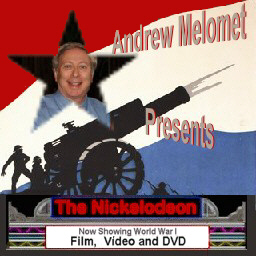 |
Caveman: V.T. Hamlin and
"Alley Oop"
Presented by Andrew Melomet
|
Vincent Trout Hamlin was born in Perry, Iowa, on May 10, 1900, and died in Spring Hill, Florida, on June 14, 1993. Hamlin is considered one of the great American cartoonists and the new documentary Caveman: V.T. Hamlin and Alley Oop from VCI Entertainment pays tribute to this World War One veteran and son of the American Mid-west.
Hamlin was small in stature as a child and as an adult, although very physically active. As a young boy he showed a talent for drawing, and when he was 11 years old his mother took him to visit 'Ding' Darling, a noted political cartoonist. His teachers were less encouraging, and as revenge Hamlin would draw caricatures of them to entertain himself and his classmates. While working as an assistant to the projectionist at the local theater Hamlin would develop an interest in time-reversal by running the film reels backwards. Time travel would later play a key development in the "Alley Oop" strip.
When he was 16, Hamlin's cartoons first started appearing in the local paper, the Perry Daily Chief. A broken hand from a rough football game sidelined him for a time. But when America entered the Great War in 1917, Hamlin enlisted before his 17th birthday. He served in France as a truck driver with the Sixth Army's Motor Transport Group and amused his fellow soldiers with sketches that often accompanied their letters home. While he was hospitalized after a poison-gas attack, Hamlin met the newspaperman Paul Bessey, who had also been wounded. Bessey encouraged Hamlin to pursue his cartooning and years later would be influential in the national syndication of "Alley Oop." While in France Hamlin learned at least two phrases in French, "Allez-hop!" and "Ooh-La-La!" An acrobat's term for a little leap and an interjection phrase of appreciation became the caveman Alley Oop and his girl friend Ooola!
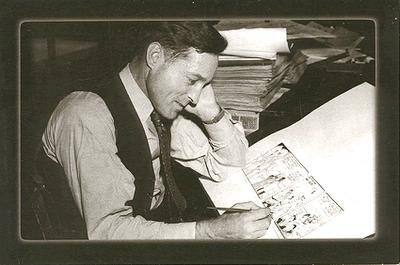
Hamlin at Work
After he was discharged in 1919, Hamlin returned to Perry to finish high school. He played more football and published cartoons in the high school yearbook, The Eclipse. In 1920 he attended the University of Missouri for one semester. He had a dispute with his art teacher about his cartooning and left school. Hamlin knocked around for a number of years. His account book for 1922 shows he earned an income of only $910. He attended Drake University for a semester while working for the Des Moines Leader as a reporter. He was an assistant to 'Ding' Darling until they had an argument. He worked as an animator for Pyramid Films and saw the publication of his first comic strip, "The Hired Hand," in the Fort Worth Star-Telegram. During Prohibition, Hamlin made counterfeit labels for bootleg liquor bottles using his paper's engraving equipment. In 1926 Hamlin married his high school sweetheart, Dorothy Stapleton. Ooola is modeled after Dorothy.
Along the way, his father accidentally shot Hamlin in the foot, and Hamlin broke his hand again as a semi-pro boxer. He worked in the Texas oil fields making maps, as a sports photographer, reported on a revolution in Mexico and eventually found himself in charge of the Art Department of the Des Moines Register. In 1930 he started to develop a strip he called "Oop the Mighty."
The path to success required syndication and Hamlin started with Bonnet-Brown, a minor syndicate of 40 newspapers. Bonnet-Brown went out of business, and Hamlin's friend Paul Bessey helped Hamlin sign with Newspaper Enterprises Association, the NEA Syndicate with 800 newspapers. The NEA was one of the first newspaper syndicates. The syndicates grew in strength with the start of World War One and allowed smaller newspapers to share the costs of news, features, columns, and comics without having to produce them in-house. NEA had a reputation for innovation, developing the telephoto transceiver, providing production facilities in railroad trains to speed up delivery and even maintaining a carrier pigeon coop so NEA photographers on ships arriving in New York Harbor could get their film to NEA faster than rival syndicates. The official start date "Alley Oop" as a daily strip was August 7, 1933. The Sunday page began September 9, 1934.
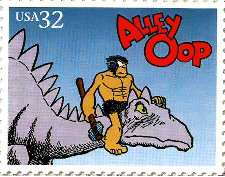
Honored by the Postal Service |
Hamlin claimed that he came up with the idea for "Alley Oop" when he was working as a cartographer for an oil company making their site maps. He could watch dinosaur bones being removed by the steam shovels and scrapers as they cleared the sites for drilling, wells, and pumps. Hamlin was on site when Discovery Well No.1 became a gusher in Iraan, Texas. He would have a life1 long interest in geology and paleontology. Iraan is home of the Alley Oop Fantasy Land theme park with oversize statues of Alley and Dinny.
Besides Alley and Ooola, Hamlin also created Dinny, Alley's pet dinosaur, and the rulers of Alley's homeland of Moo, King Guz and Queen Umpa, the treacherous Grand Wizer, and Moo's enemy the Kingdom of Lem. Moo and Lem were taking from the names of the mythical "lost continents" of Mu and Lemuria that were well-known in early 20th century pop culture. Of course, Moo also refers to the University of Missouri where Hamlin's papers remain in their Special Collections. The collection includes Hamlin's personal notated copy of Vertebrate Paleontology by Alfred Sherwood Romer, published by the University of Chicago Press. Hamlin took his dinosaurs seriously and included educational panels in the Sunday strip illustrating various prehistoric animals.
Dinosaurs were big in 1933, the same year King Kong was released. At the Chicago World's Fair known as "The Century of Progress Exhibition," there were two exhibits that featured life-size moving dinosaurs. "The World A Million Years Ago" exhibit in a big red dome was designed by Messmore & Damon of New York. A moving concourse carried visitors through displays of prehistoric men and prehistoric animals. The Sinclair Oil Company had an outdoor exhibit that recreated a prehistoric landscape populated by dinosaurs. The world of Hamlin's Oop was already in the public's mind when the strip appeared.
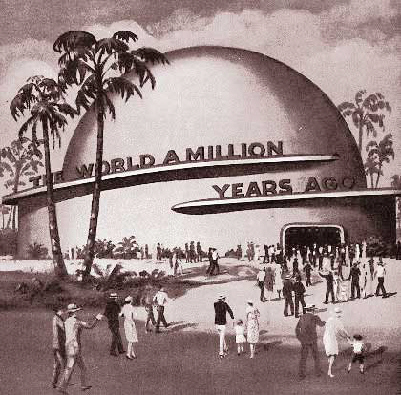
Fair Exhibit
In 1939 Hamlin's wife Dorothy suggested he introduce time travel to break free of the constraints of the prehistoric milieu. Hamlin created Dr. Elbert Wonmug (based on Einstein) and his time machine. Now Alley could storm the walls of Troy, fight in the Crusades, and march with Napoleon, meet Cleopatra, travel the American Old West, rocket to the Moon and have more fantastic adventures than just being chased by an enraged Tyrannosaurus Rex.
But even in Moo, Hamlin used "Alley Oop" to comment on the current political situation. A 1937-1938 strip had Eeny, an enemy agent from Jerooly, create a fifth column of agents called Hairshirts that enable a coup and start a dictatorship.
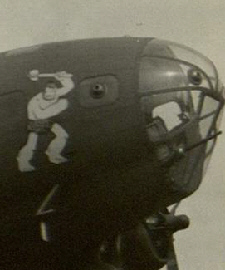
B-17 with Oop Insignia |
Hamlin tried to re-enlist when World War II started but was rejected. He designed nose art for B-17 and B-24 bombers and created the emblem of the 92nd Bomb Group. The 92nd was known as the "Oop Group." Hamlin also did an "Alley Oop" comic strip for the Army Air Force Regional and Convalescent Hospital in Nashville, Tennessee. Alley Oop tried to enlist but was turned down due to his citizenship status.
In the 1950s Hamlin, an avid outdoorsman, took up a new hobby as race car driver. In 1957 he broke both wrists when his car flipped over. His assistant Dave Graue, a World War II veteran, hired in 1950, helped out to finish the strips. When the Alley-Oop song became a hit single in 1960, Hamlin bought a new red sports car with his royalties. In the comic strip Alley bought one for himself, too.
Dave Graue would eventually fully take over the strip in 1973 when Hamlin finally retired. Dave Graue died in a car accident on December 10, 2001. He had been working with Jack Bender, who took over the strip with his wife, Carole. Over the life of "Alley Oop" only four people have worked on the strip: Hamlin, Graue, and the Benders.
At the height of its popularity "Alley Oop" appeared in over 800 newspapers. Even today it's still in 650 newspapers! The strip was also extremely popular in foreign countries, including France, Australia and Italy. In 1995 the U.S. Postal Service honored "Alley Oop" in its Comic Strip Classics series honoring the 100th anniversary of the comic strip medium.
The DVD from VCI Entertainment includes a feature length documentary on Hamlin written and directed by Max Allan Collins. Collins, an award-winning mystery writer worked with Chester Gould on the Dick Tracy comic strip for many years. Also on the DVD are commentary tracks by Collins and Jack and Carole Bender, the current writers and artists of Alley Oop which is still syndicated in over 600 newspapers. There's also a lengthy interview with Will Eisner, creator of The Spirit and a panel discussion on the strip's 75th anniversary. Order it at: http://www.vcientertainment.com
The DVD covers not only Hamlin's life but also the history of the American comic strip as seen by Hamlin and Will Eisner. One of the themes developed in the documentary and interviews is how the early artists like V.T. Hamlin, Chester Gould, and others created rich fantasy worlds that were extremely difficult to share with others. As the artists grew older and were forced to take on assistants their artistic relationships turned from mentoring to tyranny.
Click here to download the 2004-2008 Index for the Nickelodeon
with Updates on Availability of Films and Videos in the U.S.
Check the Archives for 2009's reviews.
|
|


 Recollection of the War, 1922
Recollection of the War, 1922


















